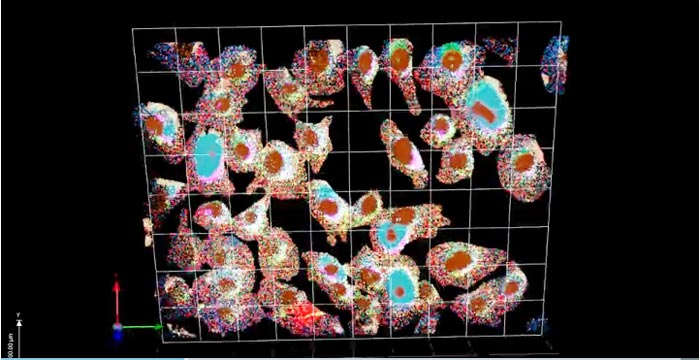

This video from the Coskun lab shows multiplexed 3D images of lung cancer cells.
Credit: Ahmet Coskun lab / Video: https://www.eurekalert.org/multimedia/960656
This year, about 240,000 people in the U.S. will discover they have lung cancer. Some 200,000 of them will be diagnosed with non-small-cell lung cancer, which is the second leading cause of death after cardiovascular disease.
Georgia Tech researcher Ahmet Coskun is working to improve the odds for these patients in two recently published studies that are essentially focused on understanding why and how patients respond differently to disease and treatments.
“What we have learned is connectivity and communication between molecules and between cells is what really controls everything, regarding whether or not patients get healthy, or how they will respond to drugs,” said Coskun, an assistant professor in the Wallace H. Coulter Department of Biomedical Engineering at Georgia Tech and Emory University.
Published in the journals npj Precision Oncology and iScience, the studies detail the development of tools and techniques to deeply explore the tumor microenvironment at the subcellular level, utilizing the Coskun lab’s expertise in combining multiplex cellular imaging methods with artificial intelligence.
“We are developing a better grasp of cellular signaling and decision making, and how it is coordinated in the tumor microenvironment, which can lead to better personalized, precision treatments for these patients,” said Coskun, who is keenly interested in why some patients respond to groundbreaking immunotherapy drugs, and some don’t.
With that in mind, his team developed SpatialVizScore, a new method they describe in npj Precision Oncology, to deeply study tumor immunology in cancer tissues and help identify which patients are more likely to respond to an immunotherapy. It’s a significant upgrade to the current standard methodology used by cancer physicians and researchers, Immunoscore.
Scoring Immunity
Immunoscore is a used as a prognostic tool, measuring how well the body’s immune cells surround and enter a tumor. It has shown promise in predicting a patient’s risk of disease recurrence, a key step in developing a personalized treatment plan. A high score indicates better immune cell infiltration, while a low score indicates a greater risk for recurrence.
But immune cells are moving targets and exhibit a high level of molecular complexity that can’t always be adequately captured by conventional Immunoscore methods. With SpatialVizScore, Coskun’s team has given immunoscoring an expanded reach.
While the standard method looks at how T cells interact with tumors, Coskun’s system looks at the interactions of additional immune cells, such as macrophages, which have two subtypes – M1 and M2, which often find themselves in conflict. M1 helps eliminate pathogens, while M2 can promote tumor growth.
Coskun’s multiplex imaging system looks at all of that, visualizing how these cells communicate and interact with each other, and with cancer cells, not just in and around the tumor, but across the tumor environment.
“Because cancer cells and immune cells are not always near each other, we visualize spatial connectivity, and we visualize communities of cells, or neighborhoods,” Coskun said. “But we’re not only looking at a cancer cell interacting with an immune cell. We’re looking at immune-immune interactions, too. By looking at the effects of these different interactions, we can explain the tumor, and we can come develop a more comprehensive immunoscore.”
Zooming In
In the iScience study, the team moves away from communities and neighborhoods of cells. Instead, they zoom in on subcellular protein-protein interaction networks, which can affect signaling pathways in cancer – when molecules in a cell work together to control a cell function, which can be cell division, or cell death.
Each molecule activates another molecule, and the process is repeated along the “pathway” until the last molecule in line is activated and the cell function – good or bad – is carried out. Abnormal activation of a pathway can lead to cancer, but some drugs target specific molecules involved and can keep cancer cells from growing.
Coskun and his team are using their multiplex imaging tools and machine learning to probe protein-protein interactions to decipher the pathogenesis of signaling pathways that contribute to drug resistance in non-small-cell lung cancer.
“We can observe and map protein activity,” said Coskun, whose team developed an imaging technique with subcellular resolution called rapid multiplexed immunofluorescence (RapMIF).
“Proteins are making the decisions that affect our cells,” Coskun added. “Now we can see how they’re communicating, how they’re affecting what our cells ultimately do. It’s a signaling discovery approach that can be used in designing precision therapies and ultimately help more patients who are battling cancer.”
CITATION: Mayar Allam, Thomas Hu, Jeongjin Lee, Jeffrey Aldrich, Sunil S. Badve, Yesim Gökmen-Polar, Manali Bhave, Suresh S. Ramalingam, Frank Schneider, Ahmet F. Coskun. “Spatially variant immune infiltration scoring in human cancer tissues.” npj Precision Oncology (Sept 2022)
FUNDING: This work was supported by start-up funds from the Georgia Institute of Technology and Emory University.
CITATION: Shuangyi Cai, Thomas Hu, Mythreye Venkatesan, Suresh S. Ramalingam, Shi-Yong Sun, Ahmet F. Coskun. “Multiplexed protein profiling reveals spatial subcellular signaling networks.” iScience (August 2022)
FUNDING: National Cancer Institute of the National Institutes of Health (P50CA217691).
Journal: npj Precision Oncology
DOI: 10.1038/s41698-022-00305-4
Method of Research: Meta-analysis
Subject of Research: Cells
Article Title: Spatially variant immune infiltration scoring in human cancer tissues
Article Publication Date: 1-Sep-2022
Media Contact
Jerry Grillo
Georgia Institute of Technology
jerry.grillo@ibb.gatech.edu














